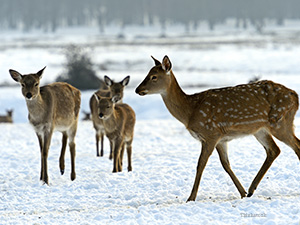
In a recent viral YouTube video posted by GoPro, a father and son rescued three deer off Albert Lea Lake in Minnesota. They came upon the deer while on their Hovercraft, and found the deer unable to get off the middle of a frozen lake. We don’t know how long these deer were struggling to get off the ice, but they appear to be exhausted and muscle fatigued.
So the father and son used a rope to secure the deer and slowly pull them off the ice to the edge of the lake. Don’t worry — while it looks like the rope may have been hurting the deer, the father and son roped the deer carefully: twice around the forelimbs (which helps spread the tension out on both legs) or around the widest part of the deer (abdomen). [Editor’s Note: Don’t try this on your own. Read Dr. Lee’s tips below and remember that you should always consult an expert or the local authorities before approaching wildlife.]
As a veterinarian, I suspect the deer were likely dehydrated, exhausted, and fatigued, as once they got to the edge of the lake, they still laid there resting until they could get their strength and legs back under them. With the GoPro camera, you can see one of the deer take off into the woods while the other rests on the side of the lake. As a fellow Minnesotan, this video makes me proud (#MinnesotaNice), as it shows that the kindness of strangers taking the time to rescue wildlife.
So, what do you do when you find wildlife in trouble?
- When in doubt, make sure that you keep yourself safe. I’ve heard of sad situations where people try to rescue a dog that fell through thin ice, only to succumb to the icy water and secondary hypothermia instead.
- Second, when in doubt, call for help (e.g., a local wildlife service, the police, etc.) if needed. That’s because when it comes to certain species, it’s better to leave them where they are. For example, if you come across baby rabbits in the spring, please leave them where they are. Unfortunately, the mortality for nursing baby rabbits is very low, so they are best left with their mother (Yes, she’ll find them as long as you don’t move them!).
- Third, if you do find wildlife, you can often bring them to a veterinarian or wildlife center near you for life-saving care. While not all veterinarians treat wildlife, they’ll be able to administer first aid and life-saving care as needed – or humane euthanasia if the creature is in severe pain.
When in doubt, contact your local wildlife service if this happens to you.
Thankfully, this father and son were able to save the wildlife in this case and all had a good outcome. A huge shout out for their brave rescue!
Click here for more wildlife advice.
WATCH THE VIDEO HERE >>
If you have any questions or concerns, you should always visit or call your veterinarian -- they are your best resource to ensure the health and well-being of your pets.
